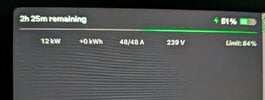ucmndd
Well-Known Member
There is no “rated 44”. This is not a thing.the vehicle is nearly 3x as fast now, which I appreciate, but thought maybe other members knew a way to bump it up to the rated 44.
Your car is charging at the full 11.5kw - 48 amps at 240 volts. That’s literally the maximum power able to be output by the wall connector and the maximum power the onboard charger in your car can accept. There is no faster. You have the fastest - congratulations.
In your particular car, a Model Y Performavce, 11.5kw of continuous power adds about 40 EPA miles of range in an hour.
In a more efficient non-performance Model Y, the exact same 11.5kw of continuous power adds about 44 EPA miles of range in an hour because that car is more efficient, and uses less energy to cover the same distance.
This is not a terribly difficult concept.



